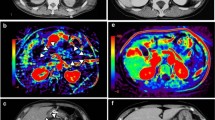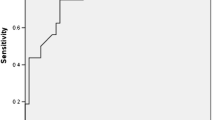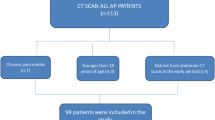Abstract
Objectives
This study explored the early predictive value of volume and mean CT density of necrosis for adverse outcomes in patients with acute necrotising pancreatitis (ANP).
Methods
A total of 155 patients with ANP who underwent CECT within 7 days of symptom onset were included. The necrosis volume, mean CT density, and modified CT severity index (mCTSI) were calculated. C-reactive protein (CRP) and blood urea nitrogen (BUN) levels both 48 h after symptom onset were reviewed. Adverse outcomes were recorded. The predictive value of each indicator was assessed using ROC curve analysis.
Results
There were significant associations between necrosis volume and mean CT density and organ failure (OF), persistent OF (POF), and need for intervention (p < 0.001 for all). For predicting OF, the area under the curve (AUC) was significantly higher for necrosis volume than for mCTSI and BUN (AUC: 0.84 vs 0.67, p = 0.0011; 0.84 vs 0.71, p = 0.0193, respectively). For predicting POF and need for intervention, the AUCs for necrosis volume were significantly higher than those for mCTSI (AUC: 0.79 vs 0.66, p = 0.0045; 0.77 vs 0.61, p = 0.0019, respectively), but did not significantly differ from those for CRP and BUN. For predicting OF, a significantly better predictive value was achieved with mean CT density than with mCTSI (AUC: 0.79 vs 0.67, p = 0.0163). There were no significant differences in predictive value between mean CT density, CRP, and BUN.
Conclusions
The volume and mean CT density of necrosis based on CECT can provide early prediction of OF, POF, and need for intervention.
Key Points
• Compared to mCTSI, necrosis volume might be used to more accurately diagnose organ failure and persistent organ failure and might be better associated with the need for intervention.
• Necrosis volume and mean CT density based on CECT are reliable quantitative predictors for organ failure, persistent organ failure, and intervention in acute pancreatitis.




Similar content being viewed by others
Abbreviations
- ANP:
-
Acute necrotising pancreatitis
- AP:
-
Acute pancreatitis
- BUN:
-
Blood urea nitrogen
- CRP:
-
C-reactive protein
- GIF:
-
Gastrointestinal fistula
- IAH:
-
Intra-abdominal haemorrhage
- ICC:
-
Intraclass correlation coefficient
- IPN:
-
Infected pancreatic necrosis
- mCTSI:
-
modified CT severity index
- NP:
-
Necrotising pancreatitis
- OF:
-
Organ failure
- POF:
-
Persistent organ failure
- RAC:
-
Revised Atlanta classification
References
Bhatia M, Wong FL, Cao Y et al (2005) Pathophysiology of acute pancreatitis. Pancreatology 5:132–144
Szentesi A, Tóth E, Bálint E et al (2016) Analysis of research activity in gastroenterology: pancreatitis is in real danger. PLoS One 11:e0165244
Samanta J, Dhaka N, Gupta P et al (2019) Comparative study of the outcome between alcohol and gallstone pancreatitis in a high-volume tertiary care center. JGH Open 3:338–343
Banks PA, Bollen TL, Dervenis C et al (2013) Classification of acute pancreatitis--2012: revision of the Atlanta classification and definitions by international consensus. Gut 62:102–111
Buter A, Imrie CW, Carter CR, Evans S, McKay CJ (2002) Dynamic nature of early organ dysfunction determines outcome in acute pancreatitis. Br J Surg 89:298–302
McKay CJ, Imrie CW (2004) The continuing challenge of early mortality in acute pancreatitis. Br J Surg 91:1243–1244
Petrov MS, Shanbhag S, Chakraborty M, Phillips AR, Windsor JA (2010) Organ failure and infection of pancreatic necrosis as determinants of mortality in patients with acute pancreatitis. Gastroenterology 139:813–820
Tenner S, Baillie J, DeWitt J, Vege SS (2013) American College of Gastroenterology guideline: management of acute pancreatitis. Am J Gastroenterol 108:1400–1415 1416
DiMaio CJ (2018) Management of complications of acute pancreatitis. Curr Opin Gastroenterol 34:336–342
Thoeni RF (2012) The revised Atlanta classification of acute pancreatitis: its importance for the radiologist and its effect on treatment. Radiology 262:751–764
Fung C, Svystun O, Fouladi DF, Kawamoto S (2020) CT imaging, classification, and complications of acute pancreatitis. Abdom Radiol (NY) 45:1243–1252
Balthazar EJ, Robinson DL, Megibow AJ, Ranson JH (1990) Acute pancreatitis: value of CT in establishing prognosis. Radiology 174:331–336
Mortele KJ, Wiesner W, Intriere L et al (2004) A modified CT severity index for evaluating acute pancreatitis: improved correlation with patient outcome. AJR Am J Roentgenol 183:1261–1265
Meyrignac O, Lagarde S, Bournet B et al (2015) Acute pancreatitis: extrapancreatic necrosis volume as early predictor of severity. Radiology 276:119–128
Johnson CD, Abu-Hilal M (2004) Persistent organ failure during the first week as a marker of fatal outcome in acute pancreatitis. Gut 53:1340–1344
Isenmann R, Rau B, Beger HG (1999) Bacterial infection and extent of necrosis are determinants of organ failure in patients with acute necrotizing pancreatitis. Br J Surg 86:1020–1024
Garg PK, Madan K, Pande GK et al (2005) Association of extent and infection of pancreatic necrosis with organ failure and death in acute necrotizing pancreatitis. Clin Gastroenterol Hepatol 3:159–166
Perez A, Whang EE, Brooks DC et al (2002) Is severity of necrotizing pancreatitis increased in extended necrosis and infected necrosis? Pancreas 25:229–233
Koutroumpakis E, Dasyam AK, Furlan A et al (2016) Isolated peripancreatic necrosis in acute pancreatitis is infrequent and leads to severe clinical course only when extensive: a prospective study from a US tertiary center. J Clin Gastroenterol 50:589–595
Mounzer R, Langmead CJ, Wu BU et al (2012) Comparison of existing clinical scoring systems to predict persistent organ failure in patients with acute pancreatitis. Gastroenterology 142:1476–1e16
Bollen TL, Singh VK, Maurer R et al (2012) A comparative evaluation of radiologic and clinical scoring systems in the early prediction of severity in acute pancreatitis. Am J Gastroenterol 107:612–619
Komolafe O, Pereira SP, Davidson BR, Gurusamy KS (2017) Serum C-reactive protein, procalcitonin, and lactate dehydrogenase for the diagnosis of pancreatic necrosis. Cochrane Database Syst Rev 4:Cd012645
Papachristou GI, Muddana V, Yadav D et al (2010) Comparison of BISAP, Ranson's, APACHE-II, and CTSI scores in predicting organ failure, complications, and mortality in acute pancreatitis. Am J Gastroenterol 105:435–442
Rau BM, Kemppainen EA, Gumbs AA et al (2007) Early assessment of pancreatic infections and overall prognosis in severe acute pancreatitis by procalcitonin (PCT): a prospective international multicenter study. Ann Surg 245:745–754
Raghuwanshi S, Gupta R, Vyas MM, Sharma R (2016) CT evaluation of acute pancreatitis and its prognostic correlation with CT severity index. J Clin Diagn Res 10:TC06–TC11
Lecesne R, Taourel P, Bret PM, Atri M, Reinhold C (1999) Acute pancreatitis: interobserver agreement and correlation of CT and MR cholangiopancreatography with outcome. Radiology 211:727–735
Cardoso FS, Ricardo LB, Oliveira AM et al (2013) C-reactive protein prognostic accuracy in acute pancreatitis: timing of measurement and cutoff points. Eur J Gastroenterol Hepatol 25:784–789
Stirling AD, Moran NR, Kelly ME, Ridgway PF, Conlon KC (2017) The predictive value of C-reactive protein (CRP) in acute pancreatitis - is interval change in CRP an additional indicator of severity? HPB (Oxford) 19:874–880
Sternby H, Hartman H, Johansen D, Thorlacius H, Regnér S (2017) IL-6 and CRP are superior in early differentiation between mild and non-mild acute pancreatitis. Pancreatology 17:550–554
Wu BU, Johannes RS, Sun X, Conwell DL, Banks PA (2009) Early changes in blood urea nitrogen predict mortality in acute pancreatitis. Gastroenterology 137:129–135
Wu BU, Bakker OJ, Papachristou GI et al (2011) Blood urea nitrogen in the early assessment of acute pancreatitis: an international validation study. Arch Intern Med 171:669–676
Lin S, Hong W, Basharat Z, Wang Q, Pan J, Zhou M (2017) Blood urea nitrogen as a predictor of severe acute pancreatitis based on the revised Atlanta Criteria: timing of measurement and cutoff points. Can J Gastroenterol Hepatol 2017:9592831
Faisst M, Wellner UF, Utzolino S, Hopt UT, Keck T (2010) Elevated blood urea nitrogen is an independent risk factor of prolonged intensive care unit stay due to acute necrotizing pancreatitis. J Crit Care 25:105–111
Jiang W, Tong Z, Yang D et al (2016) Gastrointestinal fistulas in acute pancreatitis with infected pancreatic or peripancreatic necrosis: a 4-year single-center experience. Medicine (Baltimore) 95:e3318
Hua Z, Su Y, Huang X et al (2017) Analysis of risk factors related to gastrointestinal fistula in patients with severe acute pancreatitis: a retrospective study of 344 cases in a single Chinese center. BMC Gastroenterol 17:29
Shen X, Sun J, Zhang J et al (2015) Risk factors and outcome for massive intra-abdominal bleeding among patients with infected necrotizing pancreatitis. Medicine (Baltimore) 94:e1172
Acknowledgements
We would like to thank Editage (www.editage.cn) for English language editing.
We would like to thank Jiawei Luo, PhD, West China Biomedical Big Data Center, West China Hospital, Sichuan University, for his assistance in the data analysis.
Funding
This study has received funding by the National Natural Science Foundation of China (Grant No. 81902720) and Medical Health Science and Technology Project of Zhejiang Province of China (Grant No. 2020RC015; Grant No. 2018KY396).
Author information
Authors and Affiliations
Corresponding author
Ethics declarations
Guarantor
The scientific guarantor of this publication is Feng Guo, MD.
Conflict of interest
The authors of this manuscript declare no relationships with any companies whose products or services may be related to the subject matter of the article.
Statistics and biometry
Jiawei Luo, PhD, West China Biomedical Big Data Center, West China Hospital, Sichuan University provided statistical advice for this manuscript.
Informed consent
Written informed consent was waived by the Institutional Review Board.
Ethical approval
Institutional Review Board approval was obtained.
Methodology
• Retrospective
• Diagnostic or prognostic study
• Performed at one institution
Additional information
Publisher’s note
Springer Nature remains neutral with regard to jurisdictional claims in published maps and institutional affiliations.
Supplementary information
ESM 1
(DOCX 39 kb)
Rights and permissions
About this article
Cite this article
Liu, N., He, J., Hu, X. et al. Acute necrotising pancreatitis: measurements of necrosis volume and mean CT attenuation help early prediction of organ failure and need for intervention. Eur Radiol 31, 7705–7714 (2021). https://doi.org/10.1007/s00330-021-07840-x
Received:
Revised:
Accepted:
Published:
Issue Date:
DOI: https://doi.org/10.1007/s00330-021-07840-x




